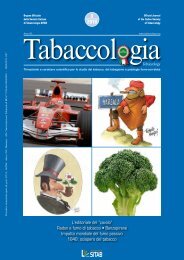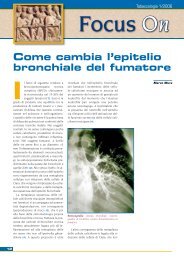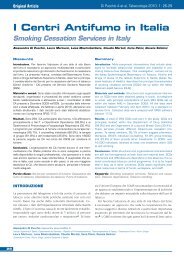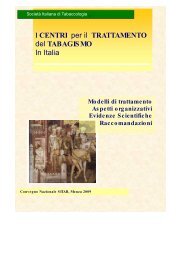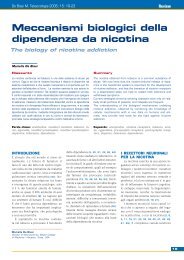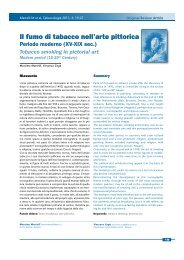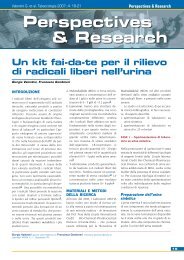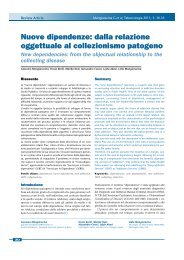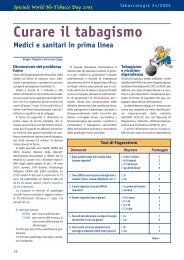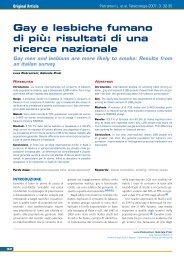Scarica n. 3/2003 - Società Italiana di Tabaccologia
Scarica n. 3/2003 - Società Italiana di Tabaccologia
Scarica n. 3/2003 - Società Italiana di Tabaccologia
Create successful ePaper yourself
Turn your PDF publications into a flip-book with our unique Google optimized e-Paper software.
Tamang E. et al, <strong>Tabaccologia</strong> <strong>2003</strong>; 3: 13-17<br />
Riassunto<br />
INTRODUZIONE. Smoke Free Class Competition (SFC) è nato in Finlan<strong>di</strong>a nel 1989 e da allora viene proposto annualmente. Dal<br />
1997 SFC è stato esteso anche ad altri Paesi europei tra i quali l’Italia, in parte finanziato dalla Commissione Europea nell’ambito<br />
del Programma “L’Europa contro il cancro”, in collaborazione con l’European Network on Young People and Tobacco (Rete europea<br />
dei giovani contro il tabacco).<br />
MATERIALI E METODI. Nel presente articolo viene descritto Smoke Free Class Competition, un programma <strong>di</strong> prevenzione al tabagismo<br />
rivolto alle classi seconde e terze delle scuole me<strong>di</strong>e inferiori ed alle classi prime delle scuole me<strong>di</strong>e superiori. Nel corso dell’a.s.<br />
2002/<strong>2003</strong> in Italia hanno partecipato a SFC sette regioni con 669 classi per un totale <strong>di</strong> 13.970 studenti. Gli obiettivi <strong>di</strong> SFC<br />
sono prevenire o ritardare l’iniziazione al fumo <strong>di</strong> tabacco tra giovani ed eliminare o ridurre il consumo <strong>di</strong> sigarette negli alunni<br />
che hanno già sperimentato il fumo, affinché non <strong>di</strong>ventino fumatori abituali. Le classi partecipanti decidono <strong>di</strong> non fumare per<br />
un periodo <strong>di</strong> sei mesi (novembre-aprile).<br />
RISULTATI E CONCLUSIONI. Gli stu<strong>di</strong> sull’efficacia <strong>di</strong> SFC suggeriscono che la partecipazione al Concorso ritarda l’iniziazione al fumo<br />
in adolescenza.<br />
Parole chiave: fumo, prevenzione, adolescenti, scuola.<br />
Abstract<br />
BACKGROUND. Smoke Free Class Competition (SFC), origin in Finland in 1989 and from 1997 it has been extended to other European<br />
countries inclu<strong>di</strong>ng Italy. SFC is partly financed by the European Commission under the Europe Against Cancer Programme<br />
and carried out in collaboration with the European Network of Young People and Tobacco (ENYPAT).<br />
MATERIALS AND METHODS. The present article describes Smoke Free Class Competition (SFC) a European project on smoking prevention<br />
for 12 – 14 year old secondary school students. It has its in the school year 2002-<strong>2003</strong> seven Italian regions participated<br />
in the project with 669 classes and 13970 students. The aim of SFC is to prevent or delay the onset of smoking habit among the<br />
teenagers and to reduce or quit smoking among students who have experimented or taken up the habit. The participating classes<br />
decided not to smoke for a period of six months (November to April).<br />
RESULTS AND CONCLUSIONS. Stu<strong>di</strong>es on the effectiveness of SFC suggests that the participation in the Competition actually<br />
delays the initiation to smoking among the teenagers.<br />
Key words: smoking, prevention, teenagers, school.<br />
Original Articles<br />
Smoke Free Class Competition<br />
E. Tamang,G. Pilati, R. Latini, A. Pettinò<br />
Introduzione<br />
Il fumo <strong>di</strong> tabacco, come ormai ampiamente<br />
<strong>di</strong>mostrato, è uno dei principali<br />
fattori che mette a rischio la salute sia del<br />
fumatore che delle persone vicine esposte<br />
al fumo passivo a tutte le età, particolarmente<br />
durante il periodo fetale e l'infanzia.<br />
In Italia si stima che circa 90.000<br />
persone all'anno muoiono per patologie<br />
<strong>di</strong>verse correlate al fumo <strong>di</strong> tabacco. Il<br />
fumo, pertanto, viene riconosciuto come<br />
la principale causa nel nostro Paese,<br />
come in tutto il mondo occidentale, <strong>di</strong><br />
morte e <strong>di</strong> malattia prevenibile e preve<strong>di</strong>bile,<br />
quin<strong>di</strong>, evitabile.<br />
Se il fumo è dannoso ad ogni età, il<br />
rischio ad esso correlato <strong>di</strong> sviluppare<br />
una patologia (car<strong>di</strong>ovascolare, oncolo-<br />
Elizabeth Tamang, Roberto Latini,<br />
Annarosa Pettinò<br />
Centro Regionale <strong>di</strong> Riferimento per la Prevenzione<br />
(CRP) Venezia<br />
gica, pneumologica) è strettamente<br />
<strong>di</strong>pendente dalla data <strong>di</strong> inizio <strong>di</strong> tale<br />
abitu<strong>di</strong>ne. Infatti, per esempio, una persona<br />
che inizia a fumare a 15 anni ha una<br />
probabilità più alta <strong>di</strong> ammalarsi <strong>di</strong><br />
tumore rispetto ad un in<strong>di</strong>viduo che inizia<br />
a fumare all'età <strong>di</strong> 20 anni. Inoltre, nell'adolescenza<br />
il fumo è associato con una<br />
maggiore gravità e suscettibilità alle<br />
Giovanni Pilati<br />
Direttore Sanitario ASS 2, Friuli Venezia Giulia<br />
13



